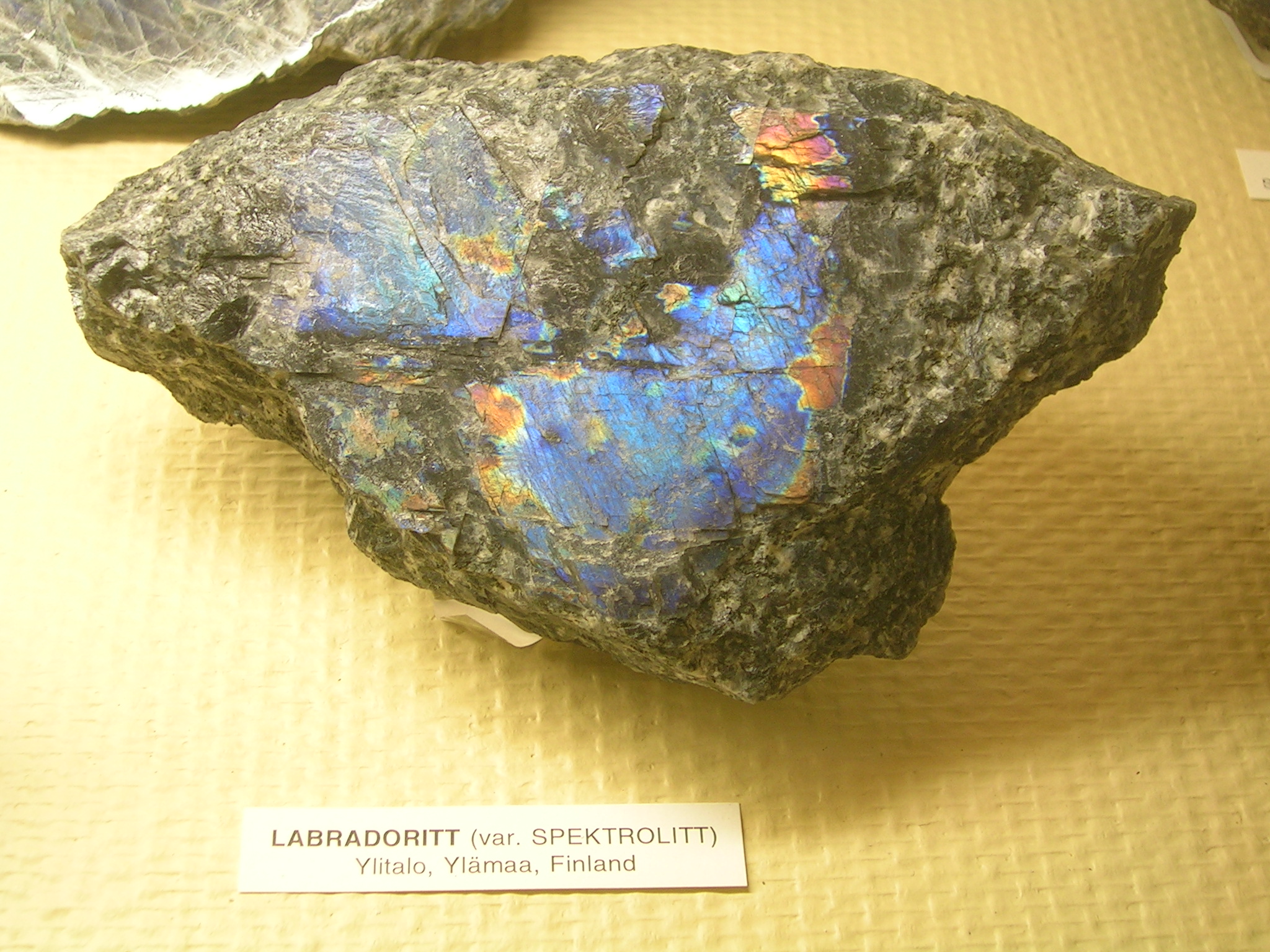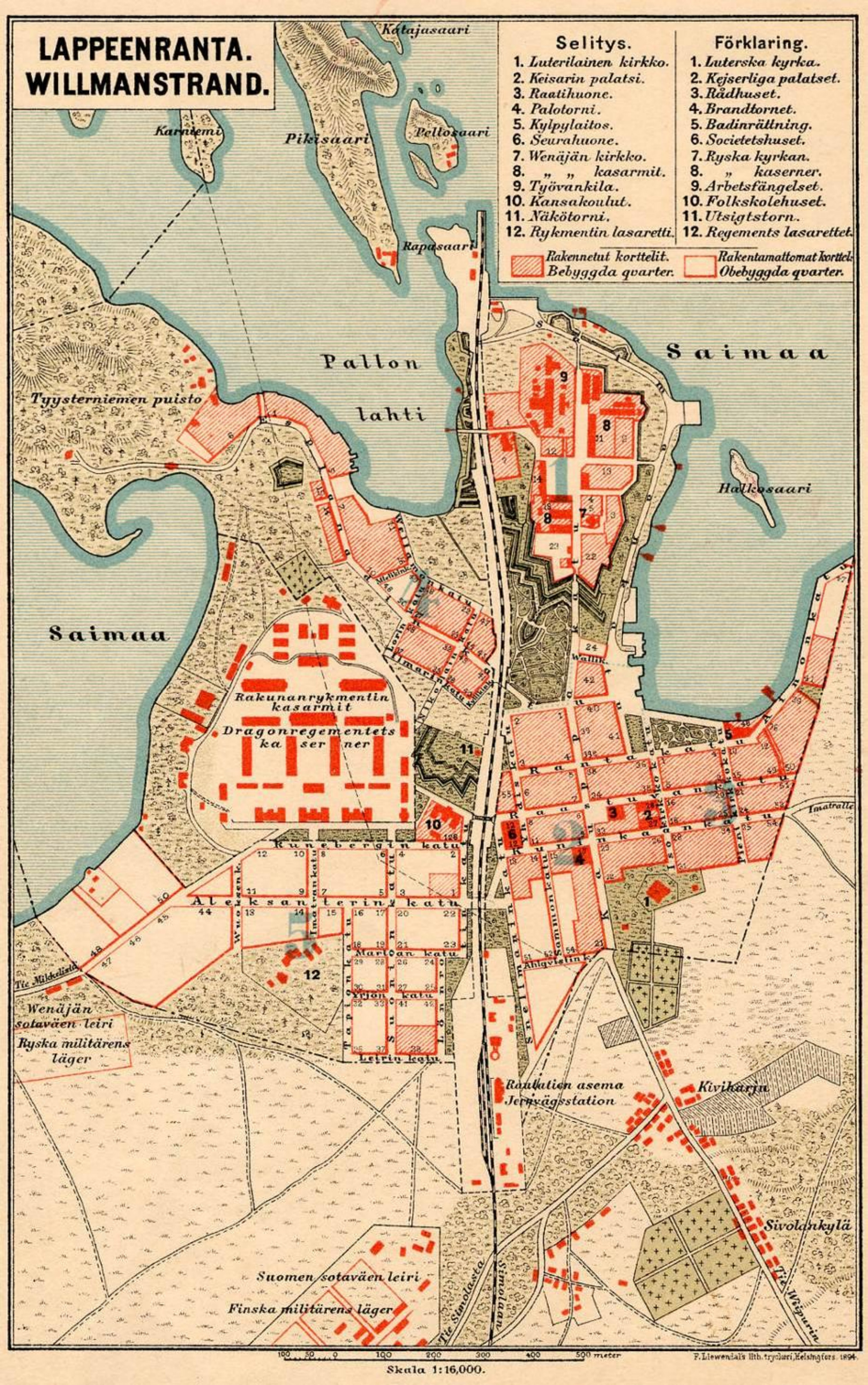|
Ylämaa
Ylämaa (; literally translated the "Highland") is a former municipality of Finland, located in the province of Southern Finland as part of the South Karelia region. It was consolidated with Lappeenranta on January 1, 2010.Jalokivistään tunnettu rajakunta joutui luopumaan itsenäisyydestään 11 vuotta sitten – nyt lähes kaikki palvelut ovat kadonneet – '''' (in Finnish) The municipality had a population of 1,408 (31 December 2009) and covers an area of of which is water. The |
Spectrolite
Spectrolite is an uncommon variety of labradorite feldspar. Colors Spectrolite exhibits a richer range of colors than other labradorites as for instance in Canada or Madagascar (which show mostly tones of blue-grey-green) and high labradorescence.Michael O'Donoghue, ''Gems'', Butterworth-Heinemann, 6th ed., 2006, pp. 238-267, Walter Schumann, ''Gemstones of the World,'' Sterling, 3rd ed., 2007, pp. 52 - 53, 182 Due to the unique colors mined in Finland, spectrolite has become a brand name for material mined only there. Sometimes spectrolite is incorrectly used to describe labradorite whenever a richer display of colors is present, regardless of locality: for example, labradorite with the ''spectrolite'' play of colors has sometimes described material from Madagascar. History Finnish geologist Aarne Laitakari (1890–1975) described the peculiar stone and sought its origin for years when his son Pekka discovered a deposit at Ylämaa in south-eastern Finland, while buildin ... [...More Info...] [...Related Items...] OR: [Wikipedia] [Google] [Baidu] |
Former Municipalities Of Finland
This is a list of the former municipalities of Finland. Contents: A B C D E F G H I J K L M N O P Q R S T U V W X Y Z Ä Ö __NOTOC__ A * Ahlainen (Swedish: Vittisbofjärd) – became part of Pori in 1972 * Aitolahti (Swedish: Aitolax) – became part of Tampere in 1966 * Akaa (Swedish: Ackas) – divided in 1946 between Toijala, Kylmäkoski, Sääksmäki and Viiala. The name was re-introduced in 2007 when the municipalities of Toijala and Viiala were consolidated. * Alahärmä – consolidated with Kauhava in 2009 * Alastaro – consolidated with Loimaa in 2009 * Alatornio (Swedish: Nedertorneå) – became part of Tornio in 1973 * Alaveteli (Swedish: Nedervetil) – consolidated with Kronoby in 1969 * Angelniemi – became part of Halikko in 1967 * Anjala – consolidated with Sippola in 1975 to form the Anjalankoski market town * Antrea (Swedish: S:t Andree) – was lost to the USSR in 1944 * Anttola – became part of Mikkeli in 2001 * ... [...More Info...] [...Related Items...] OR: [Wikipedia] [Google] [Baidu] |
Lappeenranta
Lappeenranta (; ) is a city in Finland and the regional capital of South Karelia. It is located in the southeastern interior of the country and in the Finnish Lakeland. The population of Lappeenranta is approximately , while the Lappeenranta sub-region, sub-region has a population of approximately . It is the most populous Municipalities of Finland, municipality in Finland, and the 11th most populous List of urban areas in Finland by population, urban area in the country. Lappeenranta is located on the shore of Lake Saimaa, from the Finnish–Russian border, Russian border and from the city of Vyborg. Lappeenranta is one of the most important urban centres in the entire Saimaa region, together with the cities of Imatra, Mikkeli and Savonlinna. Lappeenranta incorporated the late municipalities of Lappee and Lauritsala in 1967, Nuijamaa in 1989, Joutseno in 2009 and Ylämaa in 2010. Lappeenranta, the region's tourism centre, is the second most visited city in Finland by Russians ... [...More Info...] [...Related Items...] OR: [Wikipedia] [Google] [Baidu] |
Southern Finland
Southern Finland (, ) was a province of Finland from 1997 to 2009. It bordered the provinces of Western Finland and Eastern Finland. It also bordered the Gulf of Finland and Russia. History On September 1, 1997 the Uusimaa Province, the Kymi Province and the southern parts of the Häme Province were joined to form the new Southern Finland Province. All the provinces of Finland were abolished on January 1, 2010. Administration The State Provincial Office was a joint regional authority of seven different ministries. It promoted national and regional objectives of the State central administration. The State Provincial Office of Southern Finland employed about 380 persons. Its service offices were located in the cities of Hämeenlinna, Helsinki, and Kouvola. The administrative seat was placed at Hämeenlinna. Regions Southern Finland was divided into six regions: *South Karelia (''Etelä-Karjala / Södra Karelen'') * Päijänne Tavastia (''Päijät-Häme / Päijänne T ... [...More Info...] [...Related Items...] OR: [Wikipedia] [Google] [Baidu] |
Finland
Finland, officially the Republic of Finland, is a Nordic country in Northern Europe. It borders Sweden to the northwest, Norway to the north, and Russia to the east, with the Gulf of Bothnia to the west and the Gulf of Finland to the south, opposite Estonia. Finland has a population of 5.6 million. Its capital and largest city is Helsinki. The majority of the population are Finns, ethnic Finns. The official languages are Finnish language, Finnish and Swedish language, Swedish; 84.1 percent of the population speak the first as their mother tongue and 5.1 percent the latter. Finland's climate varies from humid continental climate, humid continental in the south to boreal climate, boreal in the north. The land cover is predominantly boreal forest biome, with List of lakes of Finland, more than 180,000 recorded lakes. Finland was first settled around 9000 BC after the Last Glacial Period, last Ice Age. During the Stone Age, various cultures emerged, distinguished by differen ... [...More Info...] [...Related Items...] OR: [Wikipedia] [Google] [Baidu] |
Mineral
In geology and mineralogy, a mineral or mineral species is, broadly speaking, a solid substance with a fairly well-defined chemical composition and a specific crystal structure that occurs naturally in pure form.John P. Rafferty, ed. (2011): Minerals'; p. 1. In the series ''Geology: Landforms, Minerals, and Rocks''. Rosen Publishing Group. The Geology, geological definition of mineral normally excludes compounds that occur only in living organisms. However, some minerals are often biogenic (such as calcite) or organic compounds in the sense of chemistry (such as mellite). Moreover, living organisms often synthesize inorganic minerals (such as hydroxylapatite) that also occur in rocks. The concept of mineral is distinct from rock (geology), rock, which is any bulk solid geologic material that is relatively homogeneous at a large enough scale. A rock may consist of one type of mineral or may be an aggregate (geology), aggregate of two or more different types of minerals, spaci ... [...More Info...] [...Related Items...] OR: [Wikipedia] [Google] [Baidu] |
Gemstone
A gemstone (also called a fine gem, jewel, precious stone, semiprecious stone, or simply gem) is a piece of mineral crystal which, when cut or polished, is used to make jewellery, jewelry or other adornments. Certain Rock (geology), rocks (such as lapis lazuli, opal, and obsidian) and occasionally organic chemistry, organic materials that are not minerals (such as amber, Jet (gemstone), jet, and pearl) may also be used for jewelry and are therefore often considered to be gemstones as well. Most gemstones are hard, but some softer minerals such as brazilianite may be used in jewelry because of their color or Lustre (mineralogy), luster or other physical properties that have aesthetic value. However, generally speaking, soft minerals are not typically used as gemstones by virtue of their brittleness and lack of durability. Found all over the world, the industry of coloured gemstones (i.e. anything other than diamonds) is currently estimated at US$1.55billion and is projected to s ... [...More Info...] [...Related Items...] OR: [Wikipedia] [Google] [Baidu] |
Finnish Language
Finnish (endonym: or ) is a Finnic languages, Finnic language of the Uralic languages, Uralic language family, spoken by the majority of the population in Finland and by ethnic Finns outside of Finland. Finnish is one of the two official languages of Finland, alongside Swedish language, Swedish. In Sweden, both Finnish and Meänkieli (which has significant mutual intelligibility with Finnish) are official minority languages. Kven language, Kven, which like Meänkieli is mutually intelligible with Finnish, is spoken in the Norway, Norwegian counties of Troms and Finnmark by a minority of Finnish descent. Finnish is morphological typology, typologically agglutinative language, agglutinative and uses almost exclusively Suffix, suffixal affixation. Nouns, adjectives, pronouns, Numeral (linguistics), numerals and verbs are inflection, inflected depending on their role in the Sentence (linguistics), sentence. Sentences are normally formed with subject–verb–object word order, alth ... [...More Info...] [...Related Items...] OR: [Wikipedia] [Google] [Baidu] |
Population Density
Population density (in agriculture: Standing stock (other), standing stock or plant density) is a measurement of population per unit land area. It is mostly applied to humans, but sometimes to other living organisms too. It is a key geographical term.Matt RosenberPopulation Density Geography.about.com. March 2, 2011. Retrieved on December 10, 2011. Biological population densities Population density is population divided by total land area, sometimes including seas and oceans, as appropriate. Low densities may cause an extinction vortex and further reduce fertility. This is called the Allee effect after the scientist who identified it. Examples of the causes of reduced fertility in low population densities are: * Increased problems with locating sexual mates * Increased inbreeding Human densities Population density is the number of people per unit of area, usually transcribed as "per square kilometre" or square mile, and which may include or exclude, for example, ar ... [...More Info...] [...Related Items...] OR: [Wikipedia] [Google] [Baidu] |
Regions Of Finland
Finland is divided into 19 regions (; ) which are governed by regional councils that serve as forums of cooperation for the Municipalities of Finland, municipalities of each region. The councils are composed of delegates from the municipal councils. The main tasks of regional councils are regional planning, the development of enterprises, and education. Between 2004 and 2012, the regional council of Kainuu was elected via popular elections as part of an experimental regional administration. In 2022, new Wellbeing services counties of Finland, Wellbeing services counties were established as part of a health care and social services reform. The wellbeing services counties follow the regional borders, and are governed by directly elected county councils. Åland One region, Åland, has a special status and has a much higher degree of autonomy than the others, with its own Parliament of Åland, Parliament and local laws, due to its history of Åland, unique history and the fact ... [...More Info...] [...Related Items...] OR: [Wikipedia] [Google] [Baidu] |
Provinces Of Finland
Between 1634 and 2009, Finland was administered as several provinces, or counties (, ). Finland had always been a unitary state: the provincial authorities were part of the central government's executive branch and apart from Åland, the provinces had little autonomy. There were never any elected provincial parliaments in continental Finland. The system was initially created by the Instrument of Government (1634), Instrument of Government of 1634 when Finland was a Finland as part of Sweden, part of Sweden. Its makeup was changed drastically on 1 September 1997, when the number of the provinces was reduced from twelve to six. This effectively made them purely administrative units, as linguistic and cultural boundaries no longer followed the borders of the provinces. The provinces were eventually abolished at the end of 2009. Consequently, different ministries may subdivide their areal organization differently. Besides the former provinces, the municipalities of Finland form the ... [...More Info...] [...Related Items...] OR: [Wikipedia] [Google] [Baidu] |





